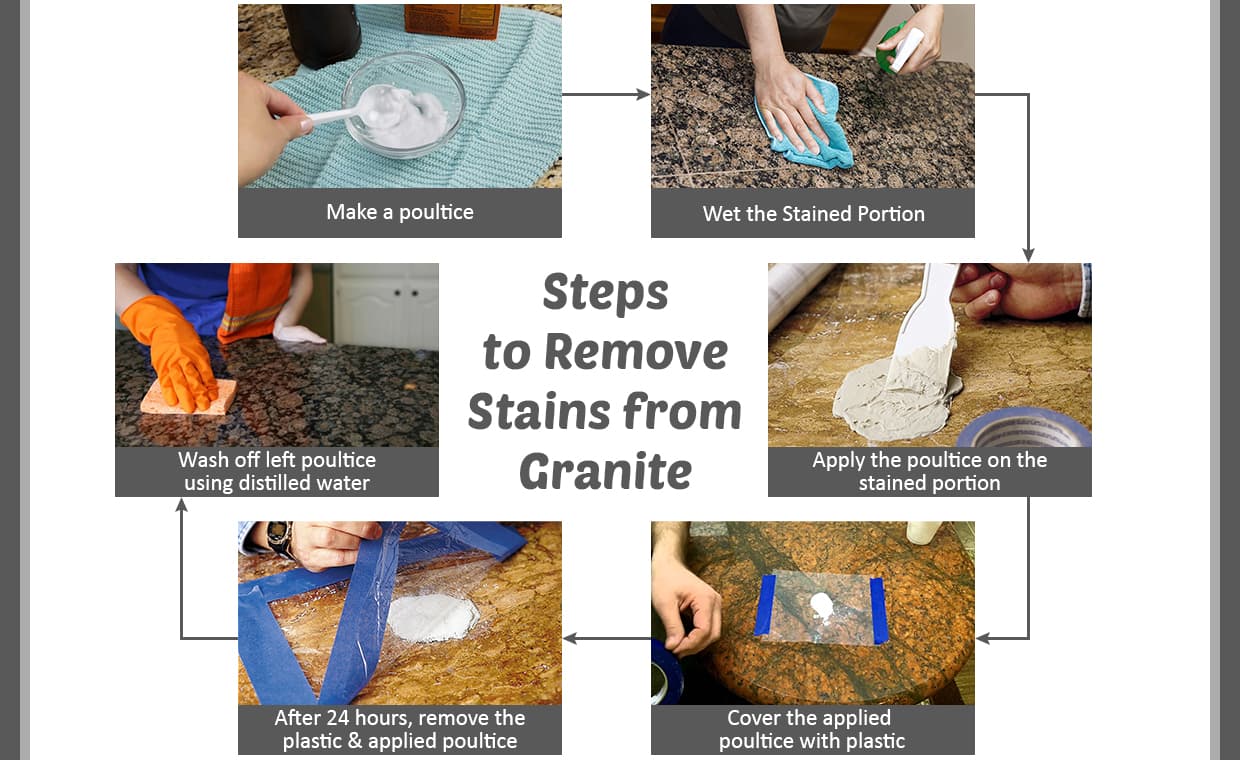
If you have spent a small fortune installing granites into your home, you should know prior to installation how to take good care of it so that you can maintain the sheen and shine of the stones installed. Although granite is a durable natural stone and less porous than other natural stones, you have to provide special attention when it comes to the question of cleaning granites.

Stain or Damage?
Removing stains from granite will concurrently be both a challenge supported by an elaborate comprehensive assessment of the spot/stain. To remove the spot, you need to make sure that it is just a stain and not a mark of damage to the surface. First, you need to decide the reason or the trigger that has caused the stain, so that you can use the appropriate ingredients to remove the spot without damaging the stone.
Now let’s talk about the action. You have toper form these following steps to determine whether the marks you see are really stains, or whether they are eroded stone patches. If you are uncertain, you should consult a professional before proceeding further for stain removal.
How to Identify Stains on Granite Surface?
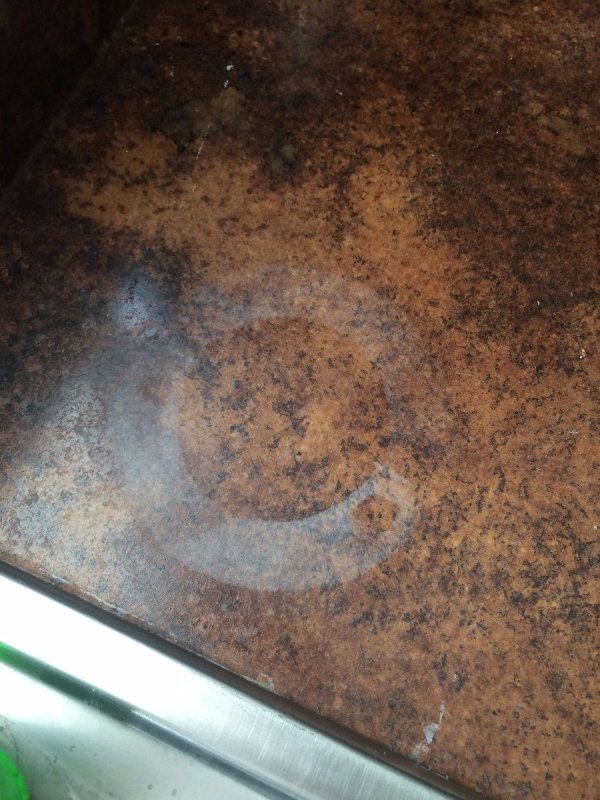
- Discolouration of the part of the granite stone will be visible if it absorbs stains from a staining agent i.e. coffee, tea, soap solution, salts or salty/hard water oil, etc. The stain will be completely removed when you will be able to remove the staining agent.
- Many a time, darker colour on the granite displays a patch on the stone-surface. You can be certain about the patch if you minutely observe the countertop and touch the patch. You will feel that the smoothness of the patch affected area is slightly uneven.
How to Identify Damage to the Granite Surface?
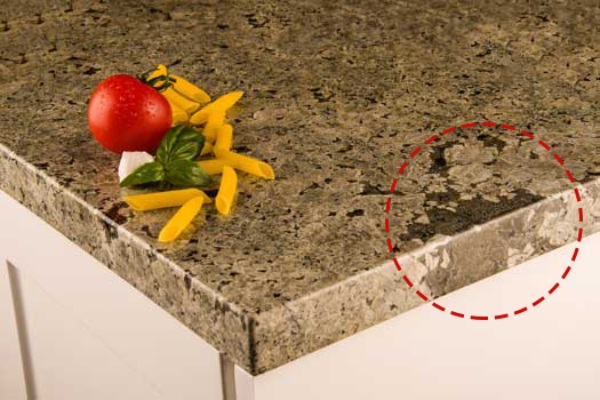
- A change in the colour of stone will be visible if it happens due to the chemical reaction in the stone caused by its exposure to acidic products such as lemon juice, soda, wine, and in most of the cases these spots are irreversible.
- Corrosion mostly caused by acids, and acidic spots tend to leave unsightly “water spots” or “rings”, and these stains hardly can be removed.
- You can hardly remove a “stain” that is actually a damage spot on the stone as it basically needs complete removal/ thorough repairing of the damaged portion.
It is much needed to identify whether the damage has affected the stone or it has impacted the protective coating or sealant (Some types of granite do not need sealants and when they are applied, they get damaged and looks like the whole area is stained.) of the stone.
If you spill something on the granite floor, it’s important to clean it off as early as possible because granite stone captures stains because of their porous nature. To prevent stains, you should follow some simple tips. If you find out any type of stains while cleaning your granite surface, first identify the type of stain. Once you identify the type of stain, your job will be easier to find the trigger behind the stain and its removal.
Below we have narrated some tips for removing stains from granite, which you can follow to clean granite surface and to maintain the surface flawlessly.
Oil Based Stains on Granite Countertops

The oil based stains i.e. stains due to cooking oil, grease will tend to darken the granite stone and the stain usually needs to be dissolved chemically. Removing these kinds of stains is easy on granite. To remove oil based stain, mix baking soda with water/acetone into a smooth paste at the consistency of pancake batter and apply the same on the stained portion of granite. Allow the paste to sit for 24 hours, then remove and wash out with the water. Repeat if necessary; some stains may need two or three trials. Reseal the surface of stone once it is done. You can also use ammonia, soft liquid cleanser, household detergent, and mineral spirit etc. to help in cleaning.
Organic Stains on the Surface of Granite
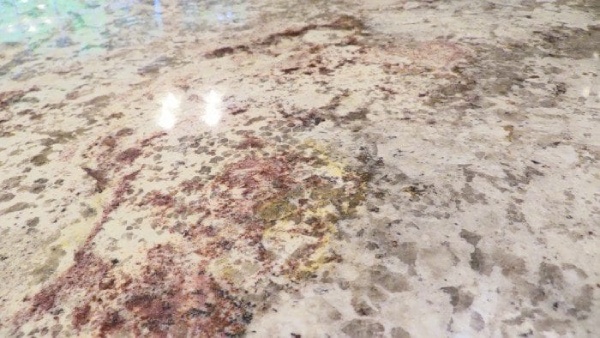
The organic stains i.e. stains due to Fruit, Coffee, Food, Paper, Urine, Leaves, Bark, Bird Droppings, etc. causes a pinkish-brown coloured stain that can disappear after you remove the source. You can clean stains with bleach cleaner, hydrogen peroxide and few drops of ammonia. If this type of stain appears on the outside area of the house, regular action of the sun and rain usually bleach out the stain. To remove organic stains, you must take a paper towel, or white terry cloth towels or cotton balls. Now soak it in liquid bleach and put it on the stained portion of granite. Allow the paper towel at least for 24 hours to be used and wash off our hands with water. Repeat if necessary. You can also sprinkle bleach on stained portion, and then rub with a soft nylon brush and clean with water. Bleach will not damage natural stone if it is sealed properly after the process is completed.
Inorganic Metal Stains on Granite
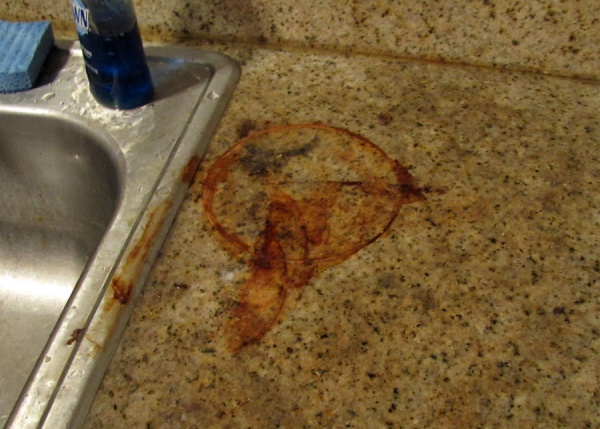
The metal stains i.e. stains due to Rust, Copper, Bronze, Iron are orange or brown in colour. It will leave the shape of the staining object like nails, bolts, screw, cans, flowerpots, etc. on the surface. Copper stains may look green or brown. Metal stains requires poultice for removal.
Rusty and deep-seated stains are mostly stubborn to handle and the stone can be stained permanently.

Poultice (A poultice is a liquid cleaner or a chemical mixed with a white absorbent material to form a paste containing the consistency of peanut butter).To make poultice, you can use fuller’s earth, kaolin, powdered chalk, diatomaceous earth, talc or white moulding plaster. Do not use iron-type clays i.e. fuller’s earth with acidic chemicals as the reactions will remove the effect of the poultice. Premixed poultices are also available in market. You only have to add water in it.
Prepare the poultice – If you are using powder, mix the cleaning agent or chemical for a thick paste. (The Consistency of the paste will be thick like Peanut butter)
Now, wet the stained portion of granite using distilled water.
Then apply the poultice on the stained portion in 1/4” to 1/2” thick layer and extend the poultice 1 inch around the stained area. Use a plastic or wood spatula for spreading the poultice uniformly.
Cover the applied poultice with plastic. Tape the edges to seal it. Allow poultice to dry properly, about for 24 to 48 hrs. The drying process pulls the stain from the granite surface. After 24 hours, remove the plastic and let the poultice to air dry.
Remove the poultice from the stained portion; wash off using distilled water, and dry it with a soft cloth. Repeat the task if stain is not yet removed. It can take five or more attempts for complete removal of the stubborn stains, and despite your trial if stains are still there, then you must contact a stone professional.
Sometimes, just like granite, tiles of your home also get stained due to accumulation of rust. You can remove these rust stains using the following tips:
Biological Stains on the Granite Surface

Biological stains i.e. stains due to mildew, algae, fungi can be directly cleaned using water. You can also use hydrogen peroxide or bleach or ammonia for cleaning of granite stain.
Note: Never mix ammonia and bleach as it produces toxic and harmful gas.
Ink Stains on Surface of the Granite
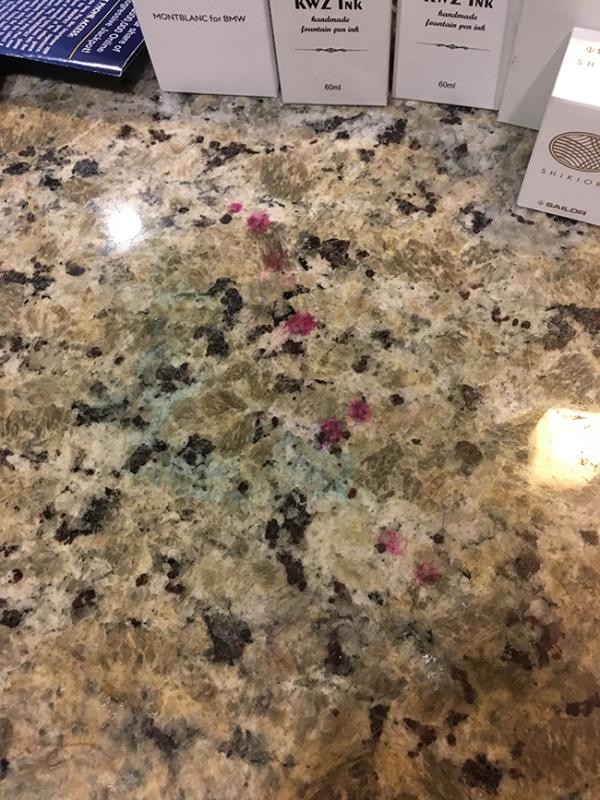
Ink stains i.e. stains due to Pen; Ink appears on light coloured granite. You can clean with bleach or hydrogen peroxide. On darker colour granite, try a solvent like lacquer thinner or acetone to remove granite stain.
Stain Due to Paint on Granite

Oil based paint, putty, preservative oils, and sealants may cause oily stains. You may remove paint stains with lacquer thinner or scrape off with knife. A heavy paint spill will require paint stripper.
Identifying the ink stains of markers and pens on granite is quite easy, as these ink patches are quite unsightly. Apply methylene chloride to clear the stain.
Water Stain on Granite Surface

Many a time, water stain is caused by the bottom of the glass it is the water stain, and it is mostly caused by the hard water. Apply mild detergent and water and rub gently the surface with a soft-bristled brush. For stubborn stain, use baking soda and water paste.
Water stains are often the spots of ring showing on the granite sealer (especially on black granite). Remove sealer with denatured alcohol. Spray it on and rub in circle with clean cloth. Repeat this process several times.
Stains Due To Damages:
Most stains due to damages can be removed by polishing. But you need to do it in a skilled way. Better contact a professional.
Summing up!
Granite countertops can look beautiful throughout the years of daily use, requiring only a minimal amount of care and maintenance. Take care of your granite using the above-mentioned tips, as after all you have invested hefty for your gorgeous granite, and you love their shine, colour and durability. Using all the aforementioned tips, removing stains from granite will be easier for you.
Also Read:
Best Tips to Buy Granite Slabs for Kitchen Countertops
Granite Countertops: All You Like to Know!
Image Courtesy:Image 1, Image 2, Image 4, Image 5, Image 6, Image 7(a), Image 7(b), Image 7(c), Image 7(d), Image 7(e), Image 7(f), Image 8, Image 9, Image 10, Image 11































